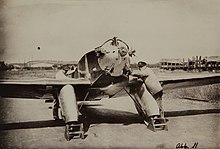Siemens & Halske Sh 4
The Siemens & Halske Sh 4 was an aircraft engine developed in the Weimar Republic by Siemens & Halske based in Berlin-Siemensstadt .
development
After the end of the First World War brought engine production to a standstill at Siemens & Halske, the construction of reduced-power engines for use in sports aircraft began in 1921 . A number of air-cooled radial engines emerged , the initial cooling problems of which could be eliminated by sheathing the steel cylinders used with aluminum ribs and by using ball bearings for the crank drive and control . The first of these was the Sh 4 with five cylinders. In 1923, the seven and nine-cylinder versions Sh 5 and Sh 6 were derived from this, both of which were equipped with two carburettors to improve mixture distribution and running safety, in contrast to the Sh 4 . About 70 units of the Sh 4 were produced.
construction
In the Sh 4 and its two successors Sh 5 and Sh 6, standard components were used to a large extent. This included the pistons , connecting rods , crankshafts , oil pumps , tappets , bumpers , valves , cylinders and rocker arms . The cylinders were made of steel with a steel bottom and aluminum ribs with an exhaust valve at the front and an intake valve at the rear. As magneto served Type F 5 Siemens. The valves were controlled by a barrel cam located in the front housing . The tappets, bumpers, rocker arms and the crankshaft ran in ball bearings, as did the main connecting rod, while the secondary rods were hinged in plain bearings .
use
- Albatros L 59
- Albatros L 71
- Caspar U 1
- Dietrich DP II
- Dietrich DP VII
- Dornier dragonfly
- Focke-Wulf A 7
- Focke-Wulf S 24
- Junkers K 16
- Junkers T 19
- Udet U 3
- Udet U 4
- Udet U 6
- Udet U 10
Technical specifications
| Parameter | Data |
|---|---|
| Manufacturer | Siemens & Halske |
| Developing country |
|
| Year of development | 1921 |
| number of pieces | 70 |
| Design | air-cooled five-cylinder - four stroke - radial engine |
| drilling | 100 mm |
| Hub | 120 mm |
| Displacement | 4.73 l |
| Compression ratio | 1: 4.7 |
| length | 854 mm |
| width | 1000 mm |
| height | 1000 mm |
| Dimensions | 104 kg |
| Unit mass | 1.89 kg / hp |
| Continuous output | 55 hp (40 kW) at 1500 rpm |
| Starting power | 62 hp (46 kW) at 1600 rpm |
| Displacement | 13.2 HP / l (9.7 kW / l) |
| Fuel consumption | 250–260 g / PSh (maximum 280 g / PSh) |
| Lubricant consumption | 12–15 g / PSh (maximum 25 g / PSh) |
literature
- Kyrill von Gersdorff, Kurt Grasmann: Aircraft engines and jet engines (= Die deutsche Luftfahrt . Volume 2 ). Bernard & Graefe, Munich 1981, ISBN 3-7637-5272-2 , pp. 44 .
- K. Grasmann (Hrsg.): Airplane type tables. DMZ 1925-1927 . 1977 (facsimile reprint Deutsche Motor-Zeitschrift No. 1 and 2/1925 and 9/1925).
Individual evidence
- ↑ Bruno Lange: Type Handbook of German Aviation Technology (= Die deutsche Luftfahrt . Volume 9 ). Bernard & Graefe, Koblenz 1986, ISBN 3-7637-5284-6 , pp. 327 .

